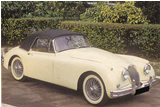
SPECIFICATIONEngine:
Straight six;83 x 106 mm, 3,442 cc; twin ohv; max power 210 bhp at 5,500 rpm
Transmission:
Four-Speed manual with optional overdrive, or Borg-Warner automatic
Suspension:
Front, independent by wishbones, torsion bars and shock absorbers: Rear, live axle, semi-elliptic springs and shock absorbers.
Brakes:
Disc brakes
Dimensions:
Wheelbase: 102 in (259cm);
Track: Front, 51 in (129 cm);
Rear: 50 in (127 cm)
Max speed:
Approx 132 mph (214 kmh) |
Jaguar XK150 1957/61
This last model in Jaguars classic XK line marked its transformation from sports car , which the late 1940's XK120 undoubtedly was, to roadster. The XK150 came 10 yrs on from the original XK introduction and the concept began to show its age...
Added comfort
XK150's were listed in fixed-head coupe, drophead coupe and roadster forms, the latter not appearing untill 1958. The body looked distinctly bulkier than its predeccessors, but the cockpit was more comfortable, and even the roadster had wind-up windows. This was a two seater, whereas the others had two miniscule occasional rear seats. The first XK with disc brakes "all round", a novelty in the late 1950s. More powerful versions of the straight six were introduced, boosting performance, from standard 210 bhp "Blue Top" to the 250 bhp "S" in 1958 and finally the 3.8 litre 265 bhp version in 1959.
Graceful
Although the XK150 had put on weight and was a little portly, it maintained Jaguar's "grace and space" publicity line, particularly in the 3.8 litre XK150's roadster. This was reflected in sales - 1466 compared with the other XK150 models. None of these cars were developed for competition.
A drophead coupe XK150, showing the much straighter top line of the wings, and for the first time on a XK, the one-piece windscreen.
Photo Autopresse
MCMXCI, Edito-Service S.A. D1 078 02-05
|